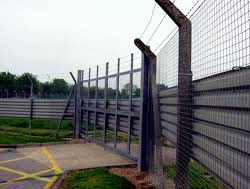When it comes to industrial fencing, cyclone, sometimes referred to as chain-link, fences are among the most popular types to use. The distinctive feature of cyclone industrial fencing is its 90-degree, diamond-shape pattern. This pattern is formed by interweaving the wires that build the actual fence. Like other kinds of fences, cyclone fences require poles to stay upright. In industrial settings, cyclone fencing is utilized to protect industrial properties, create prison perimeters and enclose athletic fields and agricultural land.

Silt fences are another kind of industrial fencing. This fencing structure is utilized to temporarily trap sediments when the soil is disturbed, which usually happens on a construction site. Depending on the area and the project, it may be required by law to use silt industrial fencing. Although silt fences are only used for a short time period, they do need to be regularly maintained.
Industrial Cyclone Fences
Cyclone fences come in rolls, which are varied in width and length. Once the roll is unrolled and secured to the poles, the fence will usually measure to at least half of a grown man's height. In some cases, the fence may extend upwards, equalling several stories. Of course, the cyclone industrial fencing's height will depend on the fence's purpose.
When cyclone industrial fencing is used in prisons, military bases and industrial sites in order to make a barrier or perimeter, the fence can be topped with razor or barbed wire. These wires have sharpened and spiked edges that are designed to catch the skin or clothing of anybody who attempts to climb the fence. Sometimes, cyclone panels are utilized in commercial and industrial settings for security purposes. With panels, potential thieves are unable to see what is on the other side of the fencing.
Industrial Silt Fences
Silt fences are made of thick, mesh fabric that is stretched between a sequence of poles. These poles are installed on a downward slope from the soil disturbance flow. It is necessary to partially back-fill the fence's up-slope section. Doing so promotes sediment filtration.
Sometimes, a site will require a series of silt fences to control the runoff of sediment. When using this type of fence, the construction crew can keep the sediments from coming into contact with waterways. These fences also keep fine materials and soils in place, effectively reducing erosion. Silt industrial fencing can also be used to make sediment filtration ponds; this allows suspended particles to filter into the ground before water goes through the fence.
The major problem of silt industrial fencing is that it tends to easily get clogged. Over time, the mesh material becomes filled with particles. At some point, the water can become trapped by particle buildup, causing the water to spill over the fence. In addition, overly used silt fencing is prone to rips and tears. This why construction sites that create a lot of sediments will need to use other tools for sediment control as silt fences alone may not be enough to handle this issue.
